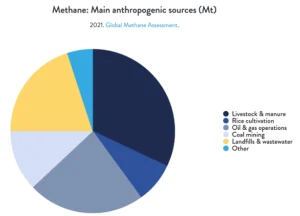The Global Methane Status Report (GMSR) 2025, released by UNEP and the Climate and Clean Air Coalition (CCAC) at COP30, warns that global efforts to reduce methane emissions are progressing too slowly to meet the 2030 Global Methane Pledge (GMP).
Why Methane Reduction Matters ?

- Methane is a potent greenhouse gas with 80 times higher warming potential than CO₂ over 20 years, and is responsible for around 0.5°C of current global warming.
- Over 60% of methane emissions come from human activity.
- Rapid reductions offer the fastest near-term climate mitigation opportunity.
- India is among the top methane emitters globally, mainly from livestock, rice cultivation, waste, and fossil fuels.
|
Key Findings of the GMSR 2025
- Emission Levels: Methane emissions reached 352 million tonnes (Mt) in 2020 and are projected to rise to 369 Mt by 2030 under current legislation.
- Key Drivers: Growth in agriculture and waste generation remains the main source of this increase.
- Target at Risk: Rising emissions move the world away from achieving the goal of 30 per cent reduction from 2020 levels by 2030, essential to keeping 1.5°C within reach.
- Slowed Growth: New waste regulations in Europe and North America, improved methane governance in major emitting economies, and cooling global gas markets between 2020 and 2024 .have helped slow projected emissions growth.
- Growing Commitments: As of June 2025, 65 per cent of Paris Agreement Parties now include methane-specific measures in their NDCs, marking a 38 per cent increase in ambition since 2020.
- Projected Decline: Full implementation of NDCs and Methane Action Plans could lead to emissions peaking this decade and falling 8 per cent below 2020 levels by 2030, representing the “largest and most sustained decline in methane emissions ever recorded.”
Sector-Wise Insights
- Energy Sector:
- Dominant Potential: Over 72 per cent of global methane reduction potential by 2030 lies in the energy sector.
- Cost-Effective Solutions: Proven interventions include leak detection and repair, venting and flaring controls, distribution network upgrades, and methane capture from oil, gas, and coal operations.
- Regulatory Gaps: While regulations have expanded since 2021, enforcement and transparency remain insufficient, particularly in the coal sector, despite technologies such as ventilation air methane (VAM) oxidation and pre-mine degasification.
- Waste Sector:
- Growing Emissions: Waste-sector methane is projected to increase 13 per cent by 2030 and 56 per cent by 2050 under current policies.
- Key Interventions: Effective measures include capturing landfill gas, diverting organic waste to composting or anaerobic digestion, enforcing disposal site standards, mandating source separation of food waste, and promoting community-level composting.
- Agriculture Sector:
- Sectoral Share: Agriculture contributes 42 per cent of global methane emissions, mostly from enteric fermentation, rice cultivation, and manure management.
- Projected Increase: Emissions are expected to rise 8 per cent by 2030 and 17 per cent by 2050 due to growing food demand.
- Mitigation Measures: UNEP identifies 24 Mt of reduction potential from feed additives, improved livestock breeding, optimised rice-water management, and bans on agricultural waste burning.
- Data and Measurement Challenges:
- Persistent Underreporting: UNEP stresses that transparent, high-quality methane data is crucial, yet underreporting continues, especially in the fossil fuel sector.
- Importance of MRV: Strengthening monitoring, reporting, and verification (MRV) systems is essential for accountability and targeted mitigation.
- Methane Finance Gap:
-
- Current Funding: Methane-focused finance reached $13.7 billion annually in 2021–22.
- Required Funding: Achieving technical mitigation consistent with the GMP requires $127 billion per year by 2030, just 6 per cent of global climate finance.
- Priority Actions: The report calls for stronger policy certainty, public and philanthropic support for project preparation, increased assistance to developing countries, and integration of methane into climate, agriculture, and energy plans.
About 2030 Global Methane Pledge (GMP)
- Launch: Launched at COP26, co-led by Canada and the European Union.
- Membership: Includes 159 countries + European Commission.
- Core Commitment: Reduce global methane emissions by at least 30% by 2030 (from 2020 levels).
- Alignment with Climate Goals: Supports keeping 1.5°C within reach while improving health, food security, and economic outcomes.
- Champions Group: Advocacy driven by Canada, EU, Germany, Japan, Micronesia, Nigeria, and the UK
About the Climate and Clean Air Coalition (CCAC)
- Type: A UNEP-led voluntary global partnership of over 200 governments, organizations, businesses, and scientific institutions.
- India joined as a member in 2019
- Focus: Targets short-lived climate pollutants, methane, black carbon, tropospheric ozone, and HFCs.
- Goal: Improve air quality and protect climate through rapid, measurable pollutant reduction.
- Approach: Their work is anchored in robust scientific analysis and practical, measures-based strategies.
- Implementation Support: Backed by a dedicated Trust Fund (CCAC Trust Fund) enabling political commitment and in-country action.
![]() 18 Nov 2025
18 Nov 2025


